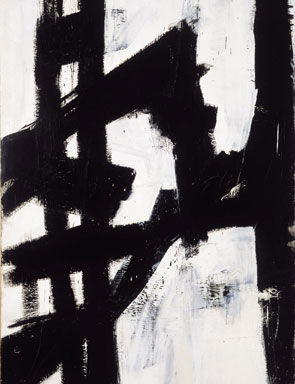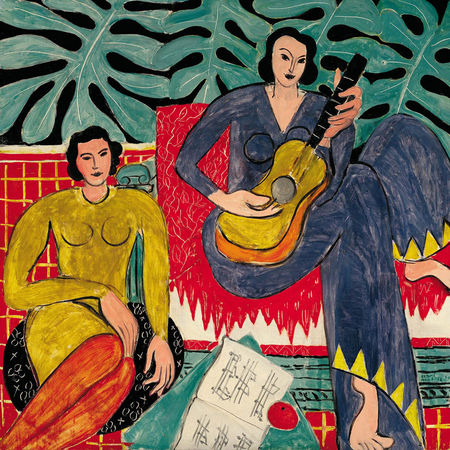Ouverture après réaménagement de la Albright-Knox Art Gallery, Buffalo
Franz Kline, New York, N.Y., 1953. Oil on canvas. Collection Albright-Knox Art Gallery, Buffalo, N.Y. Gift of Seymour H. Knox. Jr. 1956.
BUFFALO.- A new installation now on view at the Albright-Knox Art Gallery celebrates the Gallery long tradition of collecting with approximately 120 paintings, sculptures, and photographs dating from the 1850s to the present. These works from the Permanent Collection are arranged with an art historical approach according to six different themes: The Birth of Modernism, American Modernity, The Abstract Gesture, Pop Goes the World, Less is More, and Picture This.
The Birth of Modernism extends from the emergence of Impressionism with paintings by artists at the forefront of the movement such as Vincent van Gogh’s, The Old Mill, 1888 and Claude Monet’s, The Tow-Path at Argenteuil, ca. 1875. More experimental explorations of color are represented by artists André Derain, The Trees, ca 1906 and Henri Matisse, La Musique, 1939 while Pablo Picasso’s Nude Figure, 1906 and George Braque’s, Glass, Grapes and Pear, 1929 illustrate Cubism. Surrealist and German Expressionist works are also presented providing a visual timeline of the development of modern art in Europe.
A selection of American paintings from before the outbreak of the Civil War in 1860 to the beginning of the Unites States’ involvement in World War II are represented in American Modernity. The Albright-Knox, the sixth oldest art museum in the nation was established in 1862. The first painting to enter the collection, a beautiful landscape, The Marina Piccola , Capri, 1859, a gift of the artist Albert Bierstadt, is on view along with Winslow Homer’s Croquet Players, 1865; William Harnett’s still life Music and Literature, 1878; Childe Hassam’s impressionist Church at Old Lyme, Connecticut, 1905; and Arthur Dove’s semi-abstract Fields of Grains as Seen From the Train,1931.
Abstract Expressionist works represent the core of the Albright-Knox Art Gallery’s Permanent Collection. Former Director Gordon Smith and Board President Seymour H. Knox, Jr. acquired many of these works in the same year that they were created, giving the Gallery its reputation for hanging works while “the paint was still wet.” The keen intuition of these Gallery leaders, viewed by many at the time as controversial, has enabled the Albright-Knox’s collection of Abstract Expressionist works to be recognized as one of the foremost in the world. Among the iconic works on view as part of The Abstract Gesture are Blue-Black, 1952 by Sam Francis; Dialogue I, 1960 by Adolph Gottlieb; and Elegy to the Spanish Republic No. 34, 1953-54 by Robert Motherwell.
In the 1960s pop artists rebelled against the spontaneous self-expression of Abstract Expressionism by integrating familiar imagery from everyday life into their work. Pop Goes the World includes the work of Andy Warhol who turned the art world upside down with his reproductions of Campbell’s soup cans as in 100 Cans, 1962 while Robert Rauschenberg merged elements of Abstract Expressionism with found items he collaged directly on the canvas for Ace, 1962. Marisol’s intriguing wood and mixed media sculptures, Baby Girl, 1963 and The Generals are included as well as a recently acquired work by Jim Lambie, Plaza, 2005, composed of enamel paint and plastic bags.
Another group of artists responded to the expressive, painterly gestures of Abstract Expressionism by focusing on the elemental, a movement later defined as Minimalism. Artists pared images down to their most basic, structural forms and rejected any narrative or attempt at pictorial illusion. Highlights in Less is More include Frank Stella’s “black” painting, Jill, 1959 and Agnes Martin’s, The Tree, 1965 with recent acquisitions by Robert Mangold, Column Structure IX, 2006, and Fred Sandback’s Untitled (Sculptural Study, Four Part Vertical Construction, c.1982/1984.
Since its inception, the Albright-Knox Art Gallery has had a significant relationship with photography. The grouping Picture This features a range of photographs including historical works from the early part of the 20th century by Charlotte Spaulding Albright, Wilbur H. Porterfield and Augustus Thibaudeau to contemporary counterparts such as John Pfahl, Sharon Harper and Orit Raff.
This presentation of many of the best-loved works in the Gallery’s permanent collection will be on view through 2009.
Henri Matisse, La Musique, 1939. Oil on canvas. Collection Albright-Knox Art Gallery, Buffalo, N.Y. Room of Contemporary Art Fund, 1940.

/https%3A%2F%2Fprofilepics.canalblog.com%2Fprofilepics%2F1%2F0%2F100183.jpg)
/https%3A%2F%2Fstorage.canalblog.com%2F03%2F02%2F119589%2F96711876_o.jpg)
/https%3A%2F%2Fstorage.canalblog.com%2F11%2F31%2F119589%2F94773502_o.jpg)
/https%3A%2F%2Fstorage.canalblog.com%2F20%2F83%2F119589%2F94772815_o.jpg)
/https%3A%2F%2Fstorage.canalblog.com%2F26%2F72%2F119589%2F75604929_o.jpg)
/https%3A%2F%2Fstorage.canalblog.com%2F59%2F60%2F119589%2F26458628_o.jpg)




/image%2F1371349%2F20240522%2Fob_9d7d72_telechargement-24.jpg)
/image%2F1371349%2F20240522%2Fob_8d2a7d_telechargement-21.jpg)
/image%2F1371349%2F20240522%2Fob_3e69d6_telechargement-20.jpg)
/image%2F1371349%2F20240522%2Fob_120241_telechargement-17.jpg)